Advertisement
How A Drain Hole Inspired Land Artist Andy Goldsworthy's 'Watershed' At The deCordova
ResumeOn a sunny June morning, the plinking sounds of hammer and chisel rang through the woods at the deCordova Sculpture Park and Museum. A cement mixer churned at the base of a slope behind the main building.
Dusty workmen zipped in and out of a simple-looking, solid shed in process. They avoided heaps of stones and each other. Paces away, a man in a dark, body-length work apron hovered over a granite slab laying prone at his feet.
Calm as Obi-Wan Kenobi, he wielded a loud, heavy-looking wet saw to etch long grooves in the monolith. Then he looked up, took off his wide-brimmed, khaki hat and protective face mask to say, “Hello.” It was Andy Goldsworthy.
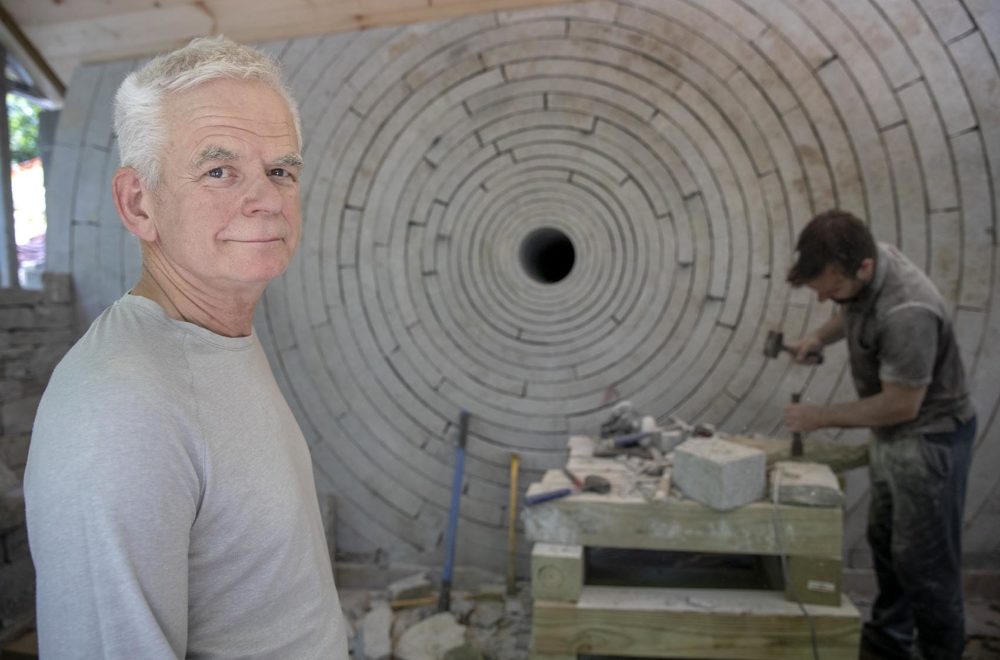
Stone by stone, the popular land artist and his team of traditional British dry-stone “wallers” have been constructing his first publicly accessible project in New England. It’s not a reach to say once it's built, the fans will come.
I was introduced to Goldsworthy through the award-winning 2001 documentary, “Rivers and Tides.” In it, the artist treks through marshes, streams and forests to painstakingly craft intricate, fragile sculptures. He uses decaying leaves, flower petals, mud, twigs, flowing water — even icicles he breaks with his teeth. The delicate objects Goldsworthy conjures are magical and fleeting. They’re made in the spirit of adventure to strike awe — then to devolve, and eventually to disappear.
“When I make a work I often take it to the very edge of its collapse,” he tells filmmaker Thomas Riedelsheimer, “and that’s a very beautiful balance.”
Then, with one tiny wrong move, and a quietly uttered “oops,” the artist’s precarious piece made of sticks suspended from a tree branch crashes around him. He rubs his eyes, then his hair, with one hand.
Goldsworthy also designs and constructs rugged, large-scale installations like the one at deCordova. They're made to last — maybe not forever, but for a good long while. He arranges fallen trees, boulders and lots of stones outdoors in varied terrains. Some of the works look like they could've been created by Druids.
But one of his muses at the sculpture park in Lincoln isn't quite as, well, earthy.
"I love drain holes," Goldsworthy declared, "you know, that interface between what we see on the surface to below... Nobody looks at them, except me.”
The 62-year-old artist spotted an ordinary drain hole in the museum's back parking lot. Now it’s the entry point for a conduit that will feed rainwater to his new, site-specific project.
“I wanted something that would go under the surface of the place, be a little internal — not just out there to be on show, but to be felt and experienced," he said. "And just conceptually, generally, that’s what I like to do. I like to look beyond the surface of things.”
Then Goldsworthy asked, “Want to go and have a look?”

The rustic shelter is like one you'd ramble past on a hike. Goldsworthy explained that when the "Watershed" is completed, visitors will be able to sit inside. If they’re lucky, it will start raining.
“They'll hear the sound on the roof,” Goldsworthy said, “it's a tin roof, so there will be the sound.”
Rain water will travel from that discovered parking lot drain to a 10-inch hole in the center of the back wall of "Watershed."
“Then if it really carries on, the water will begin to trickle from the hole. And if they get a really good storm, that [rain] will start to flow with a considerable force,” Goldsworthy predicted. “So there’ll be this kind of threat. You'll be threatened inside the building and I quite like that sense that nature doesn't stop at the walls of a building.”
Goldsworthy hopes it evokes the feeling of a flash flood, experienced up close, in a 9-by-15-foot space. All that water will seep through a carpet of gravel then back into the ground.
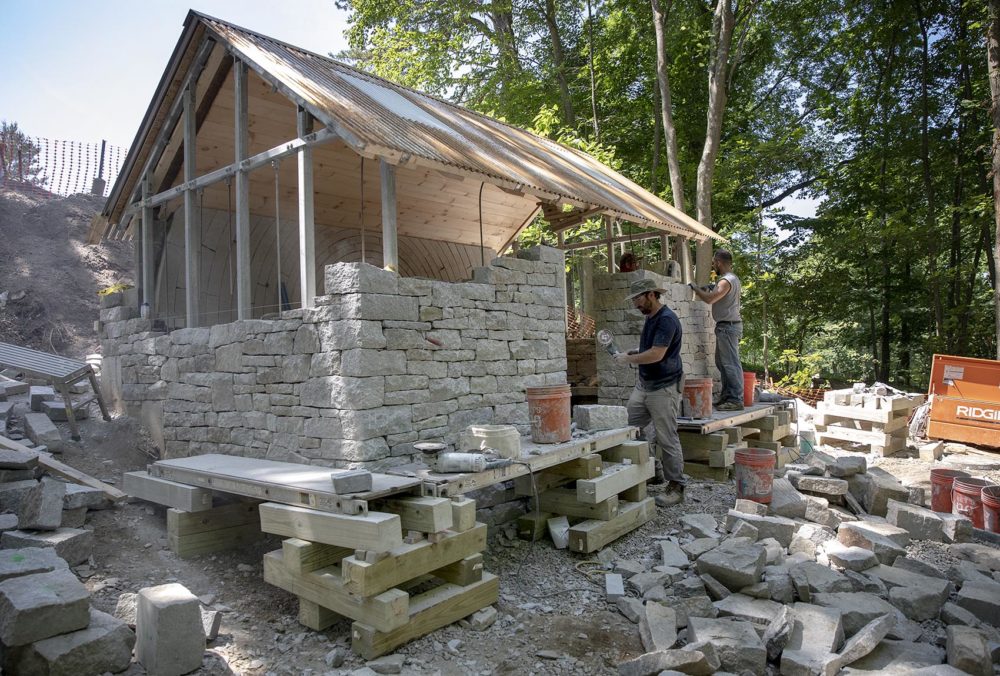
The "Watershed's" dramatic rear wall is an art piece made of smoother granite, cut and fitted like a puzzle to form concentric circles. They radiate from the opening in a pattern. It reminds me of the ripples that form after a rock is tossed into a pond, only crisper and frozen in time.
Their arcs, and the way they were crafted, are the artist's nod to the humble, curved curbstones he sees lining New England streets. Goldsworthy admires the way they channel water during a storm. To get them right, he worked with people who know them intimately: master cutters at Le Masurier Quarry, Inc. in North Chelmsford.
His wallers have been assembling the side walls with their hands. The stones are akin to those in the ubiquitous old walls that snake through New England.
“The feel of the stonework is so important — the spirit of the stonework,” Goldsworthy said, “and that's what I try and bring to the work.”
Standing in the structure’s entry, he introduced his crew from England. Gordon Wilton lives in Derbyshire and told me he’s been working with the artist for 23 years.
“Done a hell of a lot of work with him,” he said. “Beautiful stuff, too.”
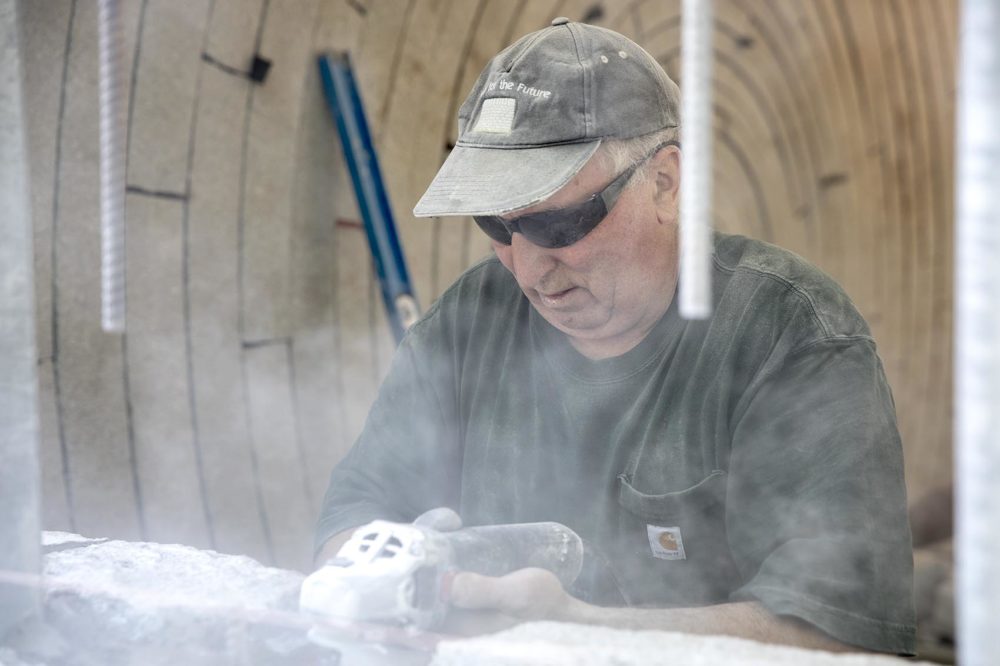
Wilton recalled the domes and passageways they've built in the past. Like Goldsworthy, he learned to be a waller decades ago while working on a farm where it’s a necessary task.
“I teach dry stone wall in back in England, but never get enough young people coming into the trade,” Wilton said. “You know, it’s like a dying art, dry-stone walling, which is sad, really.”
Wilton's proud to say his own son is also on Goldsworthy's team.
While the artist's stone projects are made to look almost effortless and as if they've been around for a while, Wilton said building them is anything but.
“It’s quite a challenge at times — sometimes we think it’s an impossibility,” he admitted. “Well, it always gets done.”
But not always the way the work began.
The deCordova project was conceived 10 years ago as an homage to historic New England ice houses. The plan was to roll a huge snowball each winter that would gradually melt inside a stone chamber.
Former deCordova curator and acting director Nick Capasso was involved in the beginning. He now heads the Fitchburg Art Museum. Back in 2011 Capasso was giddy over the prospect of Goldsworthy coming to Lincoln.
“He’s probably the best known — and arguably the best loved — contemporary artist in the world,” he gushed when we spoke.
Now, Capasso is just as excited about the "Watershed" as he was about the Snow House. In an email he told me, “The deCordova project will be the only Goldsworthy work in the public realm in New England, and will further distinguish deCordova as a leading national sculpture park.”
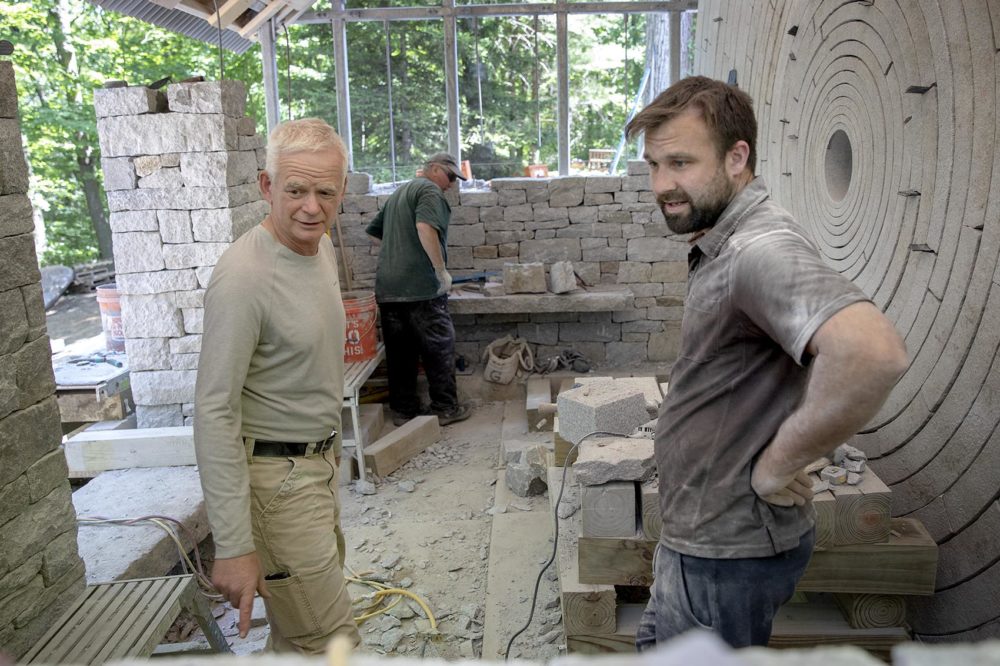
Standing over the drain hole, John Ravenal, the deCordova's third director to work with the artist, said Goldsworthy stuck with his vision while pivoting to overcome the complexity of engineering that killed the original concept.
“Andy went back to the drawing board,” Ravenal told me, “but he still created something that interacts specifically with our landscape, and with these natural phenomena that were all aware of but were not always sort of top of mind.”
The "Watershed" requires a ton of engineering, too, along with approvals from Lincoln’s Conservation Commission. That’s because the project is uphill from Flint’s Pond, the town’s water supply.
“And what's underground, and what you can't see at all, are a whole series of holding and drainage tanks where the water that's coming through the piece is being absorbed back into the ground in multiple different ways.”
Ravenal believes the "Watershed" makes something visible that so many of us overlook: the issue of run-off’s negative impact on the environment.
“Actually it's a surprising amount of water that comes off of that parking lot," he said. "And again it highlights something that we don't think about — how much land is covered with asphalt and what happens to all that water.”
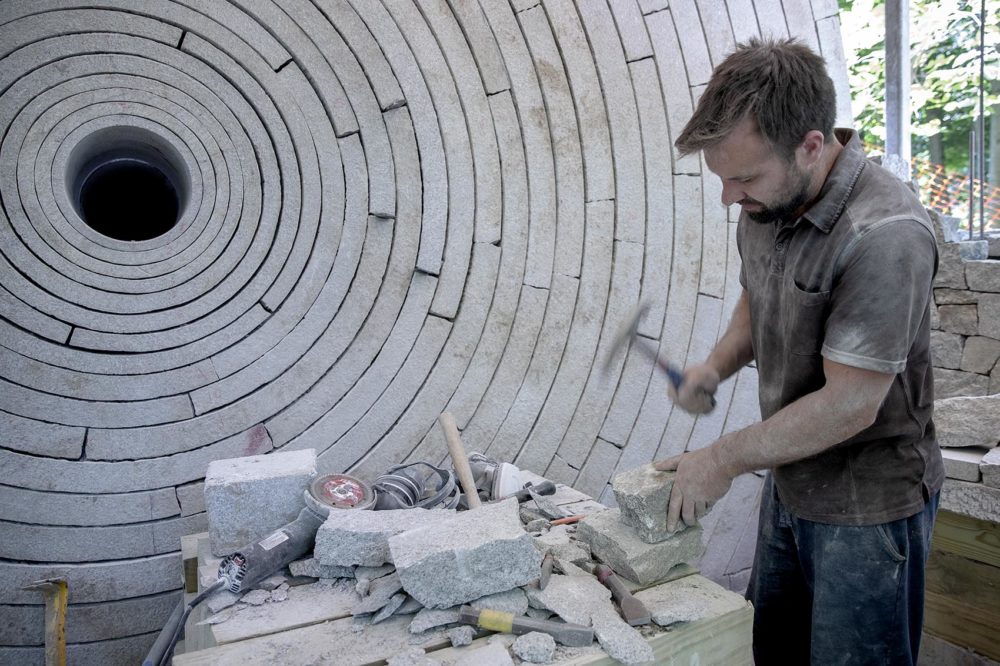
Mother Nature's myriad forces will change the "Watershed" over time as fuzzy, green moss and lichens grow across its pale gray stones. While the structure is incredibly solid, Goldsworthy said it's also vulnerable — like all of his permanent works.
“Unless they're sat in, unless they're used, they will die,” he reflected.
That's unlikely at the deCordova, though, considering the numbers of fans who make pilgrimages to see Goldsworthy's installations at places like San Francisco’s Presidio and Storm King in the Hudson Valley where I visited last summer.

In Lincoln, the artist hopes visitors will engage with the environment's cycles — its volatility and peace — whenever they enter the "Watershed."
“This will sit here dormant most of the time and then it will come to life when it rains with an unpredictability that I really like,” Goldsworthy said. “You know, granite is gravestones — it's a dead stone — this is a perfect foil for a work like this that’s going to erupt into life every so often, then go quiet again.”
If this summer's dramatic rain storms continue, Andy Goldsworthy’s "Watershed" will have plenty to say when it's officially unveiled in the fall. It opens to the public November 9.
Between now and then, extensive landscaping will embed the structure into the hillside and the drainage systems will be tested. At this moment, though, the artist still isn't completely sure it will work the way he envisions. "This is the unknown," he said with a laugh, "and it's the thrill."
This article was originally published on July 09, 2019.
This segment aired on July 9, 2019.

